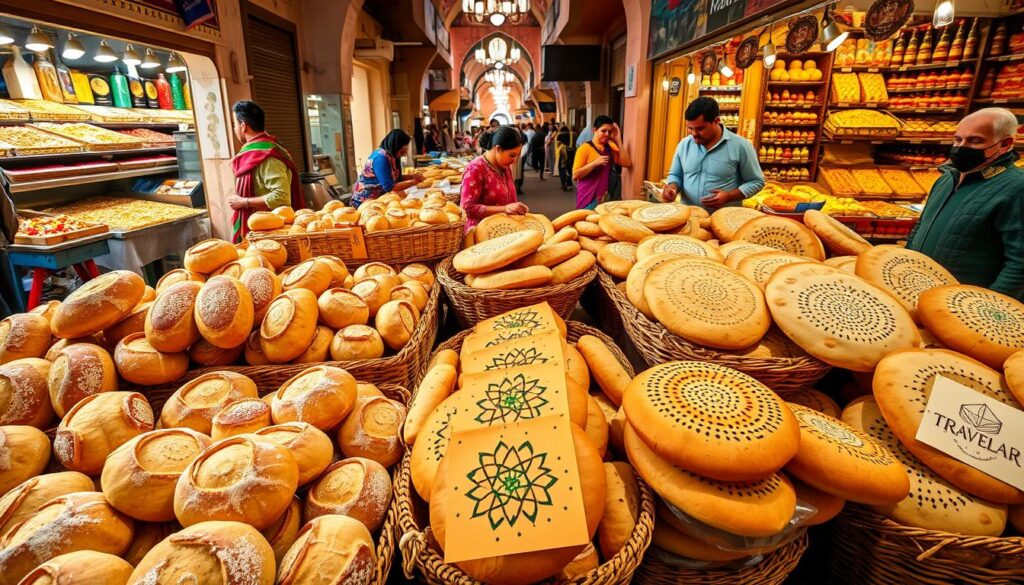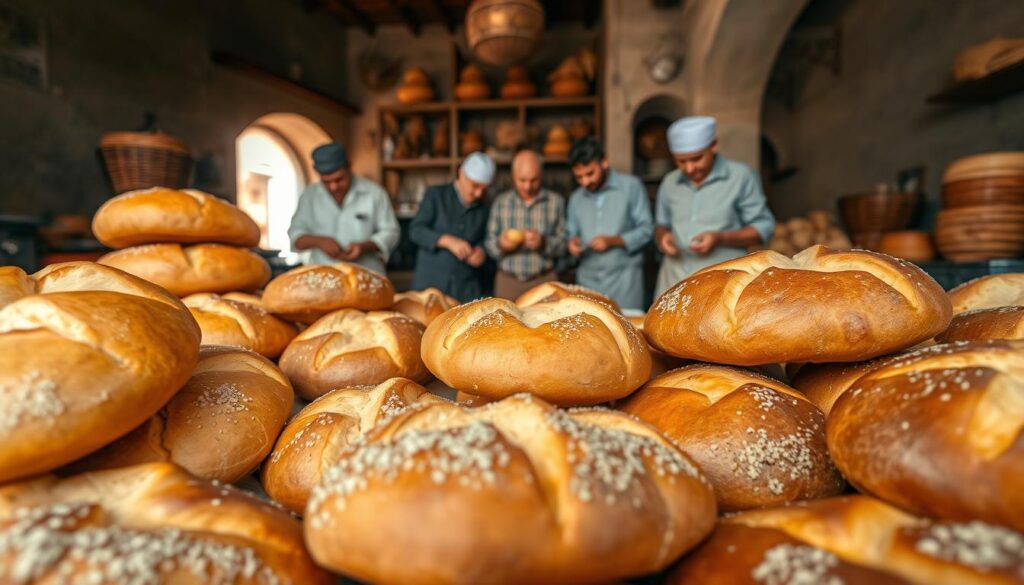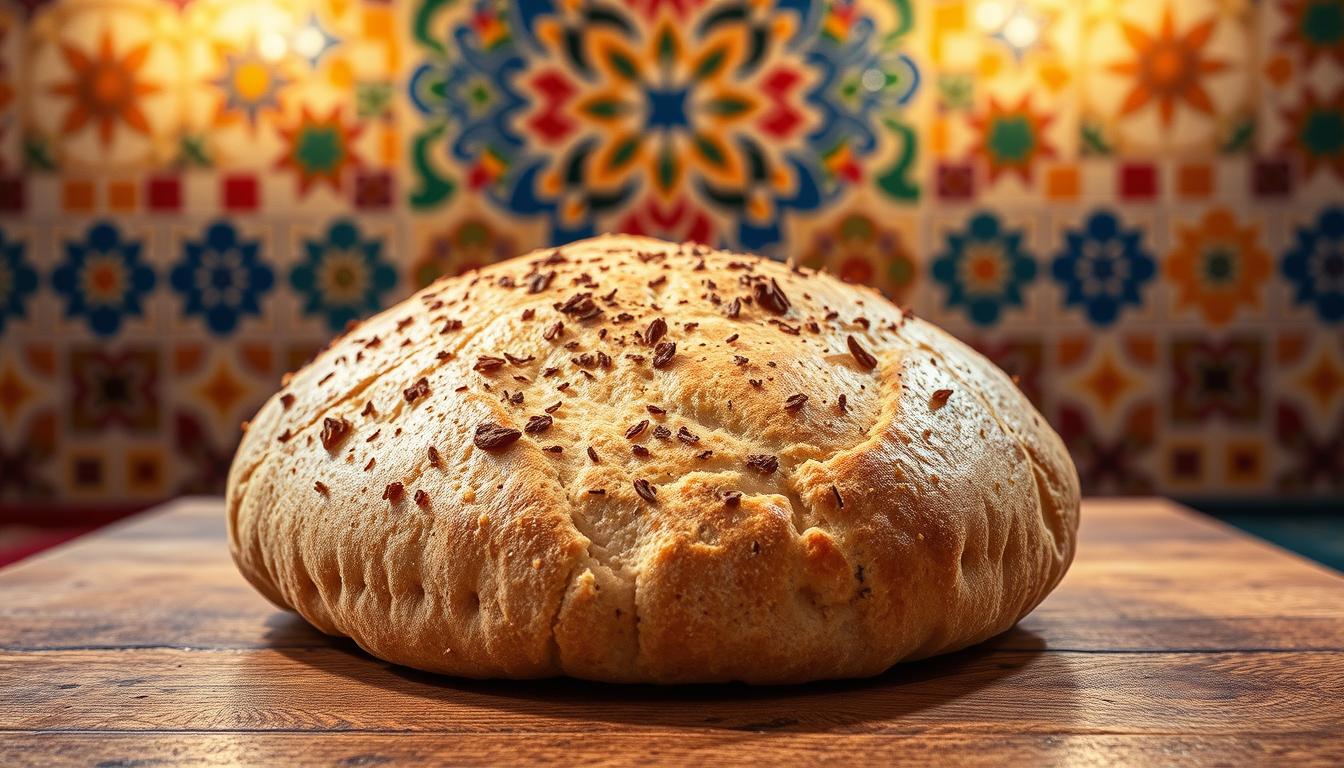What makes traditional Moroccan bread a staple in every Moroccan meal? How can you learn to bake it at home? Moroccan cuisine is rich and interesting, with bread at its heart. You’ll find different types like khobz and msemen, often topped with honey or butter.
The aromatic goodness of Moroccan bread is more than just a staple. It’s an experience waiting for you in every bite.
Introduction to Moroccan Bread
Exploring Moroccan cuisine, you’ll find traditional Moroccan bread is key in every meal. It offers diverse flavors and textures, making it an experience you’ll crave more of. From the crusty khobz to the flaky msemen, each bread has its own charm and use.
Table of Contents
The History of Moroccan Bread
Moroccan cuisine is a mix of flavors and traditions, with bread being a key part. When you think of homemade Moroccan bread, imagine the smell of fresh loaves from a local bakery. The history of bread in Morocco is tied to the country’s culture and food, shaped by many civilizations.
Exploring authentic Moroccan bread reveals a variety of tastes and textures. Each bread type, from crusty outside to soft inside, has its own special qualities. Moroccan bread’s history is a tale of cultural exchange and tradition, with each area adding its own twist.
To grasp Moroccan bread’s history, we must look at the country’s cultural and culinary roots. Influenced by Berber, Arab, and Moorish traditions, Moroccan bread has grown to be a key part of the cuisine. Enjoying a warm loaf of homemade Moroccan bread or trying different authentic Moroccan bread types lets you taste a bit of Morocco’s rich history.
Types of Moroccan Bread You Should Know
Exploring Moroccan bread reveals a variety of tasty types, each with its own charm. Moroccan flatbread is a favorite, often enjoyed with meals or as sandwich bread. To make it, you’ll need flour, yeast, and water.
Some popular types of Moroccan bread include:
- Khobz: a classic Moroccan bread known for its soft interior and crispy crust
- Msemmen: a flaky, layered bread often filled with spices and herbs
- Harcha: a semolina bread that’s perfect for sopping up sauces and stews
These breads are not just tasty; they’re also deeply rooted in Moroccan culture. Whether you’re baking a traditional recipe or trying something new, you’ll love the flavors and scents of Morocco.
Ingredients That Make Moroccan Bread Unique
Making Moroccan bread is all about the ingredients. Each one adds to the bread’s taste and feel. For example, the flour used can change the bread’s texture. Moroccan bread often mixes all-purpose, whole wheat, and semolina flours.
For more info on Moroccan bread, check out Moroccan bread recipes. Yeast is key for making the dough rise. It makes the bread light and fluffy. Use about 2 teaspoons of active dry yeast.
Spices and herbs like fennel seeds, sesame seeds, and olive oil add flavor. These ingredients make the bread taste amazing. Here are some important ingredients for Moroccan bread:
- 3½ cups of unbleached all-purpose flour
- 1 teaspoon of active dry yeast
- 1 teaspoon of sugar
- ½ teaspoon of salt
- 1 teaspoon of fennel seeds
- 1 tablespoon of sesame seeds
- 1 cup of lukewarm water
Knowing the ingredients for Moroccan bread lets you make it at home. With practice, you can make the best Moroccan bread.
How to Make Traditional Moroccan Bread
To make traditional Moroccan bread, follow a few simple steps. First, gather the necessary ingredients. You’ll need flour, yeast, salt, and olive oil. The traditional flour mix is 70% whole wheat to 30% white flour.
Many authentic Moroccan bread recipe are online. But, choose one that uses high-quality ingredients and traditional methods.
Start preparing the dough with your ingredients. Moroccan bread dough needs about 2 hours to rise. After rising, divide it into 6 pieces for individual flatbreads. Shape each piece into a ball and then flatten it into a disk.
Basic Khobz Recipe
To make a basic Khobz recipe, you need 500g of flour, 160ml of lukewarm milk, 160ml of lukewarm water, 7g of dry yeast, 10g of sugar, and 1 tsp of salt. Also, 3 tbsp of olive oil are needed. Mix the dry ingredients in a bowl, then add the wet ingredients. Mix until a dough forms.
Msemmen Preparation Steps
Msemmen is a Moroccan bread made with a thinner dough. To prepare Msemmen, roll out the dough into a thin sheet. Brush it with olive oil and fold it into a square shape. Cook the Msemmen in a frying pan or on a griddle.
Baking Techniques for Perfect Bread
To get perfect bread, use the right baking techniques. Preheat your oven to the right temperature. Use a baking stone or clay oven. Bake the bread for the right amount of time.
Try baking your bread in a traditional Moroccan clay oven. It gives a unique flavor and texture. With these tips and an authentic Moroccan bread recipe, you can make delicious homemade Moroccan bread. It will impress your friends and family.
Traditional Moroccan Bread-Baking Techniques
Exploring Moroccan cuisine reveals the importance of traditional bread-baking techniques. These methods are key to making delicious traditional Moroccan bread. They also play a big role in the culture and social life of the community. For those searching for Moroccan bread for sale, knowing these techniques can deepen their appreciation for this food.
In Morocco, baking bread is a shared activity. Many families bake together in shared ovens. This practice strengthens community ties and ensures everyone gets fresh bread. Using a tagine, a traditional clay pot, is common in Moroccan cooking. It adds a special flavor and texture to the bread.
A hot oven is essential in Moroccan bread baking. The right temperature is needed for the bread to rise well. This gives it a crusty outside and a soft inside, which Moroccan bread is famous for. Whether making simple khobz or complex msemmen, oven temperature and baking time are key.
The role of community in bread baking is also important. Many Moroccans learn bread making from their families. Recipes and techniques are passed down through generations. This keeps traditional methods alive and strengthens community bonds. For those wanting to try Moroccan bread baking, many resources are available. Cookbooks and online tutorials can help guide you through the process.
Enjoying Moroccan Bread with Traditional Dishes
Moroccan bread is a versatile staple that can be enjoyed with a variety of traditional dishes. You can pair it with Moroccan tagines, have it for breakfast, or serve it during celebrations. The key to enjoying Moroccan bread is to experiment with different combinations and find your favorite ways to incorporate it into your meals.
One popular way to enjoy Moroccan bread is to pair it with a delicious Moroccan flatbread and a variety of dips or spreads. You can also use it to make a hearty breakfast, complete with Moroccan bread recipe and a selection of cheeses, meats, and olives.
- Tagines: slow-cooked stews made with meat, vegetables, and dried fruits
- Couscous: a hearty dish made with semolina flour, water, and salt, often served with vegetables and meat
- Harira: a traditional soup made with lentils, chickpeas, and tomatoes
By incorporating Moroccan bread into your meals, you can add a new level of flavor and excitement to your dining experience. Whether you’re trying a new Moroccan bread recipe or pairing it with a traditional dish, you’re sure to enjoy the delicious taste and versatility of Moroccan bread.
How to Make Authentic Moroccan Rfissa at Home
Health Benefits of Moroccan Bread
When you think of authentic Moroccan bread, you might not think of its health perks. But, traditional Moroccan bread, made with whole grains, has many benefits. It’s good for you because of its nutrients and how it’s made.
Making homemade Moroccan bread is rewarding. It lets you pick the healthiest ingredients. Whole wheat Khobz, a key part of Moroccan food, is full of fiber and minerals. It’s a healthy choice.
Nutritional Value of Whole Wheat Khobz
Whole wheat Khobz is packed with fiber. This can lower cholesterol and boost digestive health. The way it’s made also makes nutrients easier for your body to use.
Benefits of Fermented Bread
Fermented bread, like some Moroccan types, has good bacteria for your gut. This can strengthen your immune system and help with weight. Fermentation also breaks down gluten, which is good for those sensitive to it.
Storing and Preserving Moroccan Bread
To keep your Moroccan bread fresh, store it right. You can keep it at room temperature for up to 2 days. For longer storage, freeze it. Wrap the bread tightly in plastic wrap or foil to prevent drying.
When you’re ready to enjoy your frozen bread, thaw it at room temperature or reheat it. Wrap the bread in foil and bake at 350°F (180°C) for 10-15 minutes. This will restore its freshness and flavor. Try a traditional recipe with olive oil, salt, and yeast for the best taste.
Here are some tips for storing and preserving Moroccan bread:
- Store bread at room temperature in an airtight container
- Freeze bread for longer storage
- Reheat frozen bread in the oven or at room temperature
Follow these tips to enjoy your Moroccan bread longer. Whether you’re trying a new recipe or perfecting your favorite, proper storage is key. This way, you’ll always have delicious bread ready to enjoy.
The Role of Bread in Moroccan Culture
Bread is a big part of Moroccan culture. It’s a symbol of welcome and a key part of family events. When you look for traditional Moroccan bread, it’s often fresh and served with many dishes. This shows its big role in Moroccan food.
In Morocco, bread is more than just food. It’s a way to connect with others. You can find Moroccan bread for sale in local markets or bakeries. The smell of fresh bread is everywhere. The traditional khobz is a must-have in every home, and making it is a family activity.
Here are some interesting facts about bread in Moroccan culture:
- Bread is a symbol of hospitality and is often served to guests as a sign of respect.
- Khobz is the most common type of bread in Morocco and is baked fresh daily.
- Bread is an integral part of family gatherings and celebrations, such as weddings and holidays.

In conclusion, bread is very important in Moroccan culture. It’s not just food; it’s a symbol of welcome, a way to connect, and a staple in every home. Whether you’re looking for traditional Moroccan bread or want to try making it, you’ll find the rich flavors and traditions it brings.
Exploring Modern Takes on Moroccan Bread
When you explore Moroccan cuisine, you’ll find new twists on traditional bread. There are fusion recipes, vegan, and gluten-free options. You can mix different ingredients and flavors to make your own Moroccan flatbread recipes.
Modern Moroccan bread often combines global flavors. Recipes might use traditional Moroccan tastes with international ingredients. For instance, you can add spices or herbs from other cultures to your Moroccan bread recipe.
Also, many recipes now cater to special diets. You can find vegan and gluten-free options. This way, you can enjoy Moroccan bread without worrying about your health or lifestyle. With a bit of creativity, you can make tasty and unique Moroccan bread recipe variations.
Where to Find Authentic Moroccan Bread
You can find authentic Moroccan bread in many places. This includes local markets and online stores. For the best experience, try visiting local markets and bakeries that focus on traditional Moroccan bread.
If you prefer shopping from home, there are brands and online stores that sell authentic Moroccan bread. They also offer ingredients to make homemade Moroccan bread.
Local Markets and Bakeries
Local markets and bakeries are perfect for finding authentic Moroccan bread. They offer different types like khobz, msemmen, and harcha. These are made with traditional ingredients and methods.
Popular Brands and Online Retailers
Some well-known brands sell authentic Moroccan bread. You can find it in stores or online. Online stores also have ingredients like flour, yeast, and spices for homemade bread. They also provide recipes and tutorials to help you start.
With a bit of effort, you can enjoy authentic Moroccan bread. You can buy it from a local market or bakery. Or, you can make it at home using traditional ingredients and recipes.
The Art of Bread Making as a Community Activity
Bread making in Morocco is more than just a recipe. It’s about sharing and traditions. The best Moroccan bread recipe brings people together, creating a sense of community. In many places, people come together for bread baking events.
At these events, you can learn about various Moroccan breads. You might find your new favorite recipe. Workshops and classes in the U.S. also teach bread making, giving you a cultural experience. Sharing bread can unite communities and cultures, fostering a sense of belonging.
Some benefits of bread making as a community activity include:
- Reduced stress levels through the rhythmic motion of kneading dough
- Release of endorphins, which are the body’s natural stress-relievers
- Opportunities to learn about different cultures and traditions
- Building connections with others who share similar interests

Embracing bread making as a community activity brings joy. Whether you’re trying a new Moroccan bread or perfecting a favorite, it connects people. It creates a sense of community and belonging.
Conclusion: Embrace the Flavor of Moroccan Bread
The world of Moroccan bread is full of flavors and traditions. From the simple yet versatile khobz to the flaky msemmen, each bread has a story. These stories are part of Morocco’s rich culinary history.
If you want to taste Morocco’s authentic flavors or just want to try new bread recipes, you have many options. Visit Moroccan markets and bakeries to find new recipes and techniques. Or, try modern adaptations that mix traditional and global flavors.
Bread making is a great way to connect with others. Join neighborhood bread-baking events or take workshops and classes to learn about Moroccan traditions. Sharing and celebrating Moroccan bread’s flavors nourishes your body and connects you with Morocco’s culinary heritage.

